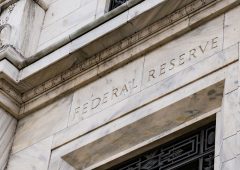Trump Escalates Trade War, Markets on Edge
13.03.2025 21:00 1 min. read Alexander Stefanov
Donald Trump has threatened new tariffs on the EU in response to its planned countermeasures against his steel and aluminum duties.
During a meeting with Ireland’s Prime Minister, he criticized the bloc’s policies and warned of further action.
Canada also hit back, announcing $29.8 billion in tariffs, while its central bank cut interest rates, anticipating economic fallout. The U.S. is now considering restrictions on copper, while the EU’s response could hit $28 billion worth of American exports. Markets fear a deeper trade conflict.
Trump’s tariff policies have alarmed business leaders and lawmakers. Tech executives met with him to raise concerns, but he remained focused on boosting domestic investment. Treasury Secretary Scott Bessent’s remark that the economy needs a “detox” worsened recession fears, sending Wall Street into decline.
ECB President Christine Lagarde warned that U.S. trade policies are fueling instability, citing tariffs as a threat to EU exports. Rising defense spending in Europe could push inflation higher, while the ECB, already grappling with uncertainty, recently cut rates to 2.5%. She stressed the need for transparency in guiding businesses and consumers through volatile conditions.
-
1
Robert Kiyosaki Predicts 2025 “Super-Crash,” Urges Hoarding Gold, Silver, and Bitcoin
23.06.2025 13:31 2 min. read -
2
Billionaire Slams Meme Stock Hype and Sounds Alarm on U.S. Fiscal Health
15.06.2025 18:00 2 min. read -
3
Nassim Taleb Says Global Trust Is Shifting from the Dollar to Gold
22.06.2025 17:00 1 min. read -
4
Billionaire Investor Sees Dollar Crash If Key Support Breaks
18.06.2025 15:00 1 min. read -
5
Geopolitical Shockwaves Hit Ethereum Hard While Bitcoin Stays Resilient
22.06.2025 16:21 1 min. read
Robert Kiyosaki Predicts When The Price of Silver Will Explode
Robert Kiyosaki, author of Rich Dad Poor Dad, has issued a bold prediction on silver, calling it the “best asymmetric buy” currently available.
U.S. PCE Inflation Rises for First Time Since February, Fed Rate Cut Likely Delayed
Fresh data on Personal Consumption Expenditures (PCE) — the Federal Reserve’s preferred inflation gauge — shows inflation ticked higher in May, potentially delaying the long-awaited Fed rate cut into September or later.
Trump Targets Powell as Fed Holds Rates: Who Could Replace Him?
Federal Reserve Chair Jerome Powell is once again under fire, this time facing renewed criticism from Donald Trump over the Fed’s decision to hold interest rates steady in June.
U.S. National Debt Surge Could Trigger a Major Crisis, Says Ray Dalio
Billionaire investor Ray Dalio has sounded the alarm over America’s soaring national debt, warning of a looming economic crisis if no action is taken.
-
1
Robert Kiyosaki Predicts 2025 “Super-Crash,” Urges Hoarding Gold, Silver, and Bitcoin
23.06.2025 13:31 2 min. read -
2
Billionaire Slams Meme Stock Hype and Sounds Alarm on U.S. Fiscal Health
15.06.2025 18:00 2 min. read -
3
Nassim Taleb Says Global Trust Is Shifting from the Dollar to Gold
22.06.2025 17:00 1 min. read -
4
Billionaire Investor Sees Dollar Crash If Key Support Breaks
18.06.2025 15:00 1 min. read -
5
Geopolitical Shockwaves Hit Ethereum Hard While Bitcoin Stays Resilient
22.06.2025 16:21 1 min. read


